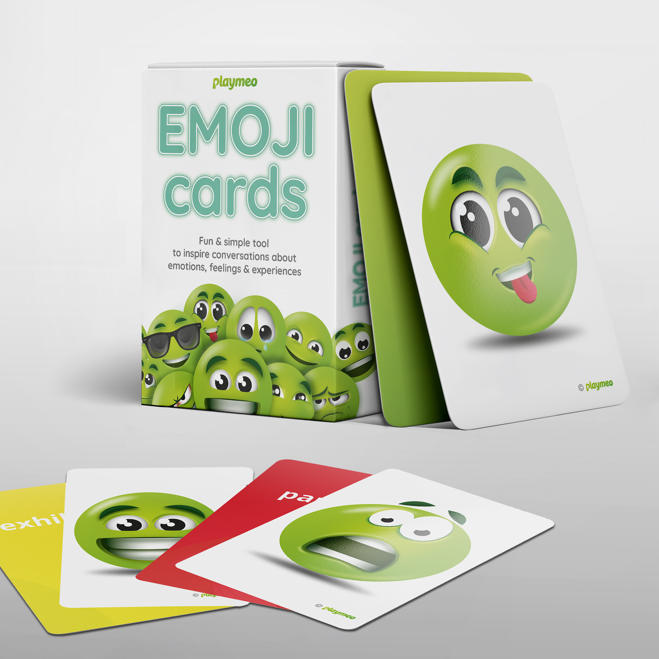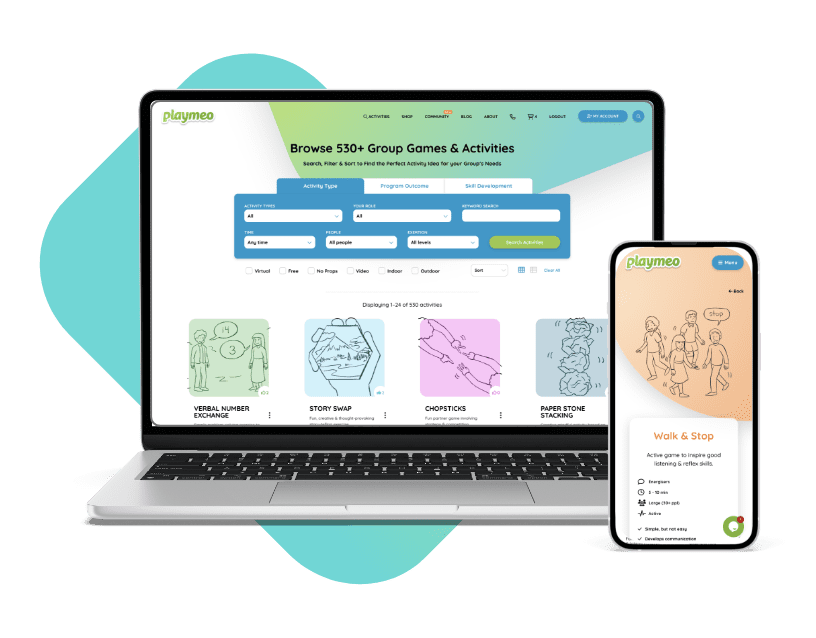Download our free 28-page ebook jam-packed with outrageously fun activity ideas.
Not all ice breaker activities are created equal.
If you’re looking for icebreaker activities that won’t cause your team to groan, yawn or roll their eyes, you’re in the right place.
Icebreakers are experiences that allow your team to get to know each other better and aim to develop stronger, more comfortable relationships. Their ultimate purpose is to amplify your team’s performance.
To be effective, ice breaker activities, especially team ice breaker games used alongside teambuilding exercises, must be fun and invite your team to interact in a non-threatening manner. They are always success-oriented and require minimal verbal and decision-making skills.
List of Ice Breaker Activities
We asked 4,500 playmeo members to share their favourite icebreaking activities. This is their top ten list, all drawn from playmeo’s ever-expanding online database of group games & activities.
Every icebreaker activity comes with simple step-by-step instructions so you can be sure to get the same results we do. Most can be adapted for use as small group icebreakers and icebreaker games for work, too.
Best of all, you won’t find this list anywhere else, ie they have been curated by a human who leads games for a living (and not a robot.)
Click the links below to scroll directly to the activity.
- Dicebreakers
- ID Numbers
- Making Connections
- This or That
- Year of the Coin
- Crosstown Connections
- Are You More Like…
- Identity Crisis
- Five Handshakes in Five Minutes
- UBUNTU Cards

Unlock playmeo FREE for 7 Days
Never be short of activity ideas again. Sign-up today. Upgrade or cancel at any time.
playmeo’s Top 10 Ice Breaker Activities
1. Dicebreakers
It’s no surprise this icebreaker sits atop the list. It’s easy to deliver, it has so many variations, and groups enjoy playing.
Here’s how to lead it.
- In advance, prepare a matrix of six ice-breaker questions and print them onto a card.
- Gather your group.
- Instruct one person at a time to throw the dice and then respond to the question that corresponds to the number that appears.
- After sharing, the first person passes the dice to the next person, and the process repeats.
- Continue until every person has been invited to share.
Group Size – 2+
Time to Play – 5 to 10 mins
2. ID Numbers
Apart from being 100% interactive, this fun icebreaking activity honours choice and invites team members to share in pairs, which means people can share in a safe place.
Oh, and having lead it 100s of times during the pandemic, it also works perfectly well with virtual audiences (check out the video below to see how it’s done:)
Here’s how to lead it:
- Distribute a blank index card and a pen to each person.
- Instruct everyone to write their first name in the top half of the card.
- In the bottom half, ask each person to write a series of numbers and letters which represent a set of interesting facts about themselves.
- For example, 1964-14Y-1K could represent a person born in 1964, married for 14 years and has one child (kid.)
- Encourage people to focus on interesting aspects of their life and experiences.
- When ready, pin the name-tags on each person’s clothing.
- Invite everyone to mix and mingle to engage in a series of conversations about their name-tags with as many people as possible.
Group Size – 2+
Time to Play – 10 – 15 mins
3. Making Connections
The stronger the connections in your group, the more you can amplify their performance, and this group game does this in spades. You only need a space large enough to form a large circle, and no props are required.
To see me lead this in action with a live group, click the play button below:
Here’s how to lead this popular icebreaker:
- Gather your group in a large open space.
- The ultimate objective is to create one large circle in which every person is physically linked with two others.
- Ask one volunteer to stand with one hand on their hip, and then share one or more statements about themselves to the group.
- When someone from the rest of the group hears a statement that they have in common with the first volunteer, they are invited to link elbows with them.
- This second person then shares something about themselves to the larger group, to attract a new person to link elbows with them, and so on.
- This process of sharing and linking continues one by one.
- To complete the circle, invite the last person to join the long chain of connections to share something about themselves to link with the very first volunteer.
Group Size – 10+
Time to Play – 5 to 10 mins
4. This or That
Tere is so much to love about this exercise, it’s hard to pull away from it after 4 or 5 rounds. The sky is the limit when it comes to the types of questions you could ask, but always start with something easy – such as Sunset or Sunrise – and then build up to something that involves a bit more thought, such as Woudl you prefer to be rich in a job you hate or poor in a job you adore?
Follow these instructions to lead this fun game:
- Form pairs.
- Pose a question in which each person must choose between two difficult, hypothetical propositions, eg Coke or Pepsi, dark chocolate or white chocolate, video games or board games, etc.
- Each person considers their choice and shares this decision with their partner.
- Next, each person predicts the preference of the majority of people in their group, and shares this prediction with their partner.
- When ready, ask everyone to stand to one side of a space (or the other) according to their personal choice to determine the majority preference of the group.
- Each person who accurately predicts the group’s (majority) preference earns a point.
- Repeat this process, asking as many questions as you have time or energy to explore.
Group Size – 10+
Time to Play – 15 to 20 mins
5. Year of the Coin
This is one of those games you wish you had thought of a long time ago. And, most groups are equipped to play at almost any time, anywhere.
Here’s what you need to do:
- Randomly distribute a collection of coins to your group, one per person. Or, ask each person to pull one from their pocket.
- Ask each person to identify the year of the coin embossed on the coin.
- Taking turns, invite each person to share a story about something they experienced that year.
- If the year occurs before the birth of the person holding the coin, invite them to share something they can remember about that year in history.
- Continue until everyone has shared.
Group Size – 2+
Time to Play – 10 to 15 mins
6. Crosstown Connections
When I first learned this energiser (as a participant) I was struck by how simple the activity was at generating lots of random interaction. But, by simply adding a bunch of opportunities that invited partners to share, it transformed this exercise into an awesome ice-breaking experience.
Here’s how to play:
- Demonstrate a particular handshake with a volunteer, eg high-five, fist-bump, elbow tap, etc.
- Invite everyone to find one partner to practice this greeting according to random criteria you nominate.
- Demonstrate a second handshake/greeting with a new volunteer, eg low-five.
- Again, invite everyone to find a new partner – according to new nominated criteria – to practice this latest handshake.
- Introduce two, three or four more unique handshake/greetings, asking people to find a new partner each time.
- For fun and to reinforce established partnerships, randomly call the name of a particular greeting to challenge everyone to locate their partner as quickly as possible.
- Adopt one or more variations to squeeze extra value from this interaction.
Group Size – 10+
Time to Play – 15 to 20 mins
7. Are You More Like…
This interactive group game is ideal if you are looking to celebrate commonalities and differences within groups. You’ll need a few minutes in advance to prepare a set of Are You More Like… cards, but you can use them over and over again.
Here are the step-by-step instructions to play this game:
- Create a set of ‘Are You More Like…’ questions, such as CAT-DOG, SLIDE-SWING, LADDER-TREE, EXPLORER-SETTLER, LANDING-TAKE-OFF,
MOVIE-TELEVISION, GIVER-RECEIVER, etc. - Organise the cards with one set of paired statements (a match) for every two people.
- Randomly distribute one card to each person.
- When ready, instruct each person to mingle with others until they find the person holding a card with their match, eg UP is matched with DOWN.
- Once matched, invite partners to share their response to the question posed by the conjunction of their two cards, eg Are You More Like… a CAT or a DOG?
- Encourage people to share as much as they feel comfortable.
- When ready, randomly re-distribute the cards and start again.
- Continue this matching, sharing and re-distributing process for 10 to 15 minutes.
Group Size – 10+
Time to Play – 10 to 15 mins
8. Identity Crisis
This interactive group game punches well above its weight in terms of impact. It’s easy to present, play and always triggers bursts of laughter towards the end of the activity.
Here’s what you need to do:
- Distribute a set of blank index cards to your group, one per person.
- Ask everyone to write their first name on a card, in large letters.
- Pose three questions and invite everyone to consider their responses, eg favourite movie, ideal holiday location, and what they would do if they won the lottery.
- Over the next few minutes, invite everyone to have a short conversation with a partner, introducing themselves and especially sharing these three bits of information.
- After this mutual exchange, instruct everyone to swap (name) cards and identities, ie each person assumes the identity of their partner, including the three bits of information they just learned about their partner.
- Each person then seeks a new partner, and introduces themselves using their new identity.
- Continue playing for 10 or more minutes, inviting each person to complete as many exchanges (and swaps of identity) as possible.
- To conclude, form a circle, and invite each person to introduce the person named on the card they are holding to the group.
Group Size – 12+
Time to Play – 10 to 15 mins
9. Five Handshakes in Five Minutes
One of the best parts of this highly interactive game is the enormous number of ways you can present the various greetings. I’m pulling from a long list of 20+ fun, interactive greetings to bring you this fun icebreaker.
And if you’d like to see what it looks, sounds and feels like, click the play button below to see it led by a facilitation expert in Nate Folan:
Here’s what you need to do to amplify the energy of the start of your program:
- Assemble your group.
- Introduce a series of fun handshake greetings, one at a time.
- For example, and by demonstration with a volunteer, engage in a typical ‘high-five’ greeting. Other options include ‘low-five,’ ‘elbow tap,’ and ‘fist-bump.’
- Invite each person to engage in a ‘high-five’ greeting with as many people in the group as possible in less than 20 seconds.
- Demonstrate a second innovative handshake greeting, eg a fist-bump, inviting your group to try it out with as many people as possible in less than 20 seconds.
- Repeat this process with three more interesting greetings.
Group Size – 20+
Time to Play – 2 to 5 mins
10. UBUNTU Cards
I’m glad this activity made the cut-off for the Top Ten list because it sits inside my top 3 or 4 interactive icebreakers. Indeed, I could easily lead 2 or 3 hours of interaction using this one highly versatile resource.
If the word “ubuntu” is unfamiliar to you, it literal translation from the Zulu language is “I am because we are.” Everything you do with these cards is designed to identify things in common with others and celebrate diversity.
To see UBUNTU Cards in action, check out this video of me leading it with a group of PE teachers.
Armed with a deck of UBUNTU Cards, this is one of many dozens of ways you can use this resource to break the ice:
- Form pairs.
- Distribute one UBUNTU card to every person.
- When ready, each person shows the multi-image face of their card to their partner.
- The first person to identify the one object that appears on both cards wins.
- Next, invite each pair to have a conversation in which they explore something that they each have in common.
- After a minute of conversation, each person swaps cards and seeks out a new partner.
- Continue this process of seeking commonalities for 5 to 10 minutes.
- Try one or more variations.
Admittedly, it is difficult to substitute a deck of UBUNTU cards with something else, but I promise you – it is well worth the small investment for your team. You WILL use these cards over and over again.
Group Size – 8+
Time to Play – 10 to 30 mins
How Do Icebreakers Work?
There are five key ingredients of an effective icebreaker. That is to say, simply playing games at the beginning of your program does not mean they will work to break the ice. Indeed, in many instances, what you may refer to as an icebreaker may, in fact, be an ice-maker!
For an experience to be effective, it must be fun, highly interactive, non-threatening, simple, and success-oriented.
Click the button below to search, filter and sort 100s of icebreaker activity options.













four thousand five hundred voters! wow.
Yep! And.. you may have been one of them, JeWElle. If you have ever Liked any of playmeo’s activities, then you voted.
yeyyyyy!